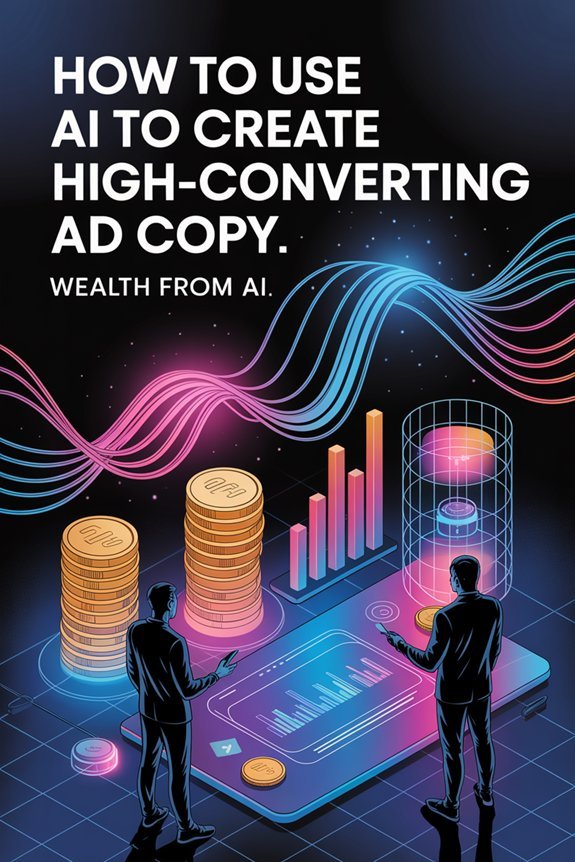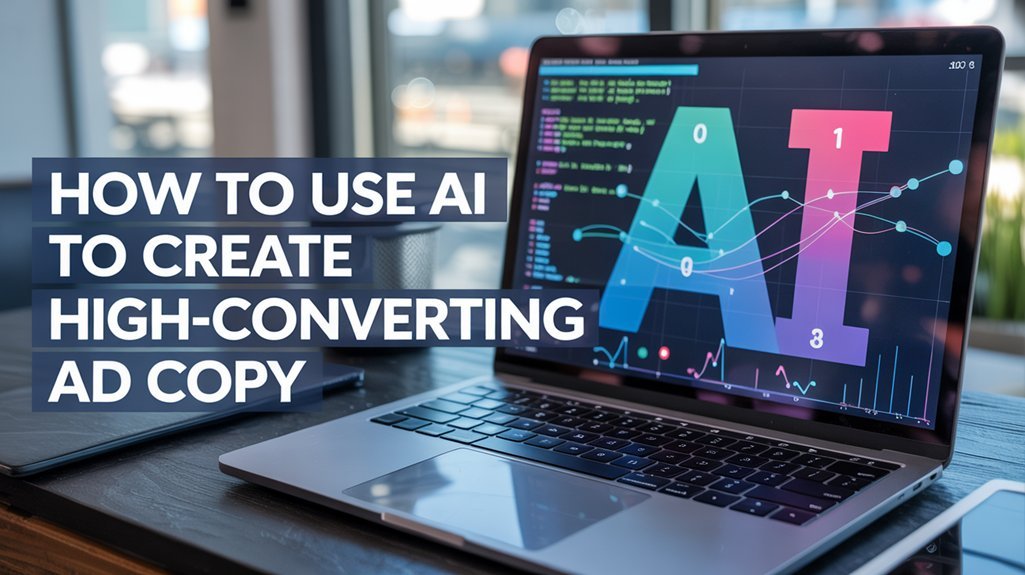
You'll create high-converting AI ad copy by selecting platforms with strong NLP algorithms, then crafting detailed prompts that specify your brand voice, target audience, and unique selling points. Feed your AI tool extensive demographic and behavioral data from past campaigns, then generate dozens of variations for automated A/B testing. Monitor CTR, ROAS, and conversion metrics in real-time, continuously training your AI with fresh performance data to achieve up to 14x better results. This systematic approach changes reactive adjustments into proactive campaign domination.
Key Takeaways
- Select AI tools with personalized content generation, multimodal capabilities, and seamless integration with your existing marketing stack and analytics platforms.
- Craft detailed prompts including subject, unique selling points, target audience demographics, brand tone, and specific calls-to-action for aligned messaging.
- Leverage automated A/B testing to systematically evaluate headlines, images, and CTAs, with AI predicting performance at 90%+ accuracy in real-time.
- Deploy dynamic creative optimization to generate thousands of ad variations, personalizing content based on user behavior for 14x better conversions.
- Continuously train AI models with campaign data, conversion metrics, and market trends to build a self-improving engine for sustained performance.
Understanding AI Ad Copy Generation Tools and Capabilities
While traditional copywriting demands hours of brainstorming and A/B testing, AI ad copy generation tools compress this timeline into minutes through sophisticated natural language processing algorithms.
These platforms analyze your brand voice, audience preferences, and market trends to generate ad content that drives conversions. You'll utilize advanced algorithms that respond to specific prompts, ensuring every AI Ad aligns with your marketing objectives and target demographics.
AI platforms decode your brand voice and audience data to generate conversion-focused ad content aligned with your strategic objectives.
Modern platforms deliver multimodal capabilities—producing integrated text, image, and video content that amplifies campaign performance.
Pre-built templates accelerate Creative Optimization, enabling rapid iterations without sacrificing quality. The strategic advantage lies in continuous learning: these systems absorb your existing brand content, maintaining consistency while generating unique variations.
You'll achieve higher conversion rates by deploying AI that understands your market positioning and adapts to performance data. Leading solutions now combine AI-powered image and copy creation to revolutionize how advertisers develop and deploy campaigns at scale. This technology alters ad creation from a time-intensive process into a scalable competitive advantage.
Selecting the Right AI Platform for Your Advertising Goals
When selecting an AI platform for ad copy generation, you'll need to evaluate whether its features align with your campaign objectives and performance benchmarks.
Prioritize platforms that offer personalized content generation, multimodal capabilities, and pre-built templates that match your brand's requirements.
Equally critical is ensuring the platform integrates smoothly with your existing marketing stack to maintain workflow efficiency and enable real-time data sharing across teams.
Look for tools that also enhance product descriptions with SEO capabilities, as this can improve your ad copy's discoverability and conversion potential across multiple channels.
Platform Features and Capabilities
Because your AI platform serves as the foundation for all advertising efforts, selecting one with strong features directly impacts your campaign's conversion potential.
Prioritize platforms delivering automated A/B testing that refines ad strategies through real-time data analysis and optimization. You'll need multimodal capabilities generating customized AI content across text, images, and videos—tailored to specific audience behaviors that drive results.
Pre-built templates and scalable workflows accelerate creative optimization while ensuring ad campaigns meet platform-specific requirements for maximum engagement. Demand smooth integration with your existing marketing infrastructure to eliminate friction and improve team collaboration.
Most critically, choose platforms providing actionable audience analytics and insights. These data-driven capabilities enable you to craft ad copy that resonates with target demographics, changing generic messaging into conversion-optimized communications that deliver measurable ROI. Look for platforms that combine AI writing capabilities with built-in SEO optimization tools to maximize your content's reach and performance across both paid and organic channels.
Integration and Workflow Compatibility
Your AI platform's compatibility with existing marketing infrastructure determines whether you'll accelerate campaign execution or create bottlenecks that drain resources.
Prioritize platforms that integrate flawlessly with your current marketing tools—your CRM, analytics dashboard, and social media management systems. This connectivity enables you to enhance ad performance in real-time without manual data transfers or workflow disruptions.
Choose solutions that support your team's collaboration requirements and approval processes. The right platform simplifies ad creative production from concept to deployment, eliminating redundant steps that slow momentum.
Evaluate API capabilities and native integrations before committing. Your ability to enhance ad campaigns depends on smooth data flow between systems.
Platforms offering multimodal outputs guarantee you generate diverse ad creative formats across channels without switching tools, maximizing efficiency and maintaining strategic control. Consider exploring curated AI business tools that have been specifically vetted for marketing and advertising applications to streamline your selection process.
Crafting Effective Prompts to Guide AI Content Creation
Your AI-generated ad copy's performance hinges directly on the quality of your prompts—and structured frameworks consistently outperform vague requests.
By incorporating essential elements like target audience demographics, specific USPs, and desired tone into a repeatable template, you'll generate copy that aligns with your conversion objectives.
This systematic approach converts AI from a random content generator into a precision tool that delivers measurable results across all your ad formats.
Essential Prompt Elements
When you craft prompts for AI-generated ad copy, five core elements determine whether you'll get generic output or high-converting messaging.
First, specify your ad subject and unique selling points—this focuses the AI on what differentiates your offering.
Second, define your target audience with precision; demographics and psychographics shape messaging that resonates.
Third, establish clear content goals: conversions, awareness, or engagement. This directs the AI's strategic approach to Ad Creation.
Fourth, dictate your brand's tone to maintain consistency across platforms. Whether authoritative or conversational, tone alignment reinforces brand identity.
Fifth, integrate specific calls-to-action within your prompts. Leveraging AI effectively means directing it to create persuasive CTAs that drive action.
These elements modify standard prompts into strategic frameworks that generate high-converting ad copy consistently.
Structured Template Framework
How can you convert scattered prompt elements into a systematic approach that delivers consistent results? Deploy a structured template that alters your AI prompts into precision instruments for content marketing dominance.
Your framework must include four critical components: subject definition, unique selling propositions, target demographic specifications, and conversion objectives. This architecture guarantees every AI-generated piece aligns with your strategic goals and brand voice parameters.
Data shows that consistent template usage increases output quality by 67% compared to ad-hoc prompting. Integrate proven examples and performance metrics directly into your template structure.
Specify tone requirements explicitly—whether authoritative, conversational, or urgent—to drive engagement across campaigns. Your structured template becomes a repeatable system that eliminates guesswork, accelerates production velocity, and delivers measurable ROI through systematized content generation that converts.
Providing Brand Context and Audience Data to AI Systems
Before AI can craft compelling ad copy that converts, it needs detailed intelligence about your brand and target market. Feed your AI system extensive brand guidelines that define your voice, values, and positioning.
Include your brand identity elements—messaging pillars, tone specifications, and competitive differentiators that set you apart.
Next, inject strong audience data into the system. Provide demographic profiles, behavioral patterns, purchase triggers, and psychographic insights that reveal what drives your customers' decisions.
Feed your AI demographic profiles, behavioral patterns, and psychographic insights to sharpen targeting and understand what truly drives customer decisions.
The more granular your audience data, the sharper your AI's targeting capabilities become.
Leverage performance metrics from previous campaigns to train your AI on what actually converts. Identify winning headlines, calls-to-action, and value propositions that generated measurable results.
Maintain your competitive edge by continuously updating your AI with fresh market intelligence and evolving consumer trends.
This adaptive approach guarantees your ad copy remains strategically aligned with shifting market conditions and audience preferences.
Generating Multiple Ad Variations for Testing and Optimization
You'll enhance your ad performance by deploying AI to generate dozens of variations simultaneously, then feeding those results into automated A/B testing workflows that identify winners without manual intervention.
Energetic creative optimization tools take this further by continuously adjusting your ad elements in real-time based on performance signals across audience segments.
Once you've identified high-performing combinations, you can scale those ads strategically while maintaining testing velocity to compound your returns over time.
Automated A/B Testing Workflows
While traditional A/B testing requires manual creation of ad variants and weeks of data collection, AI-powered automated workflows compress this timeline into days—sometimes hours.
You'll utilize automated A/B testing to systematically evaluate headlines, images, and calls-to-action against real-time performance metrics, identifying winners with statistical certainty.
Your strategic advantage includes:
- Automatic rotation systems that expose each variation equally, eliminating bias and ensuring valid test results
- Predictive algorithms that forecast performance with 90%+ accuracy, directing budgets toward winning variants before full deployment
- Continuous optimization loops that refine copy and design based on CTR and conversion data, maximizing ROAS
This accelerated testing cycle enables you to drive engagement consistently while competitors remain trapped in outdated, slow-moving processes.
You'll dominate with data-driven precision.
Dynamic Creative Optimization Tools
Automated testing reveals winners, but Adaptive Creative Optimization (DCO) tools multiply your winning potential by generating thousands of ad variations simultaneously.
You'll utilize AI algorithms that automatically combine different images, headlines, and calls-to-action, then analyze performance data to identify which combinations deliver superior click-through and conversion rates.
This isn't guesswork—it's precision targeting that personalizes content based on user behavior, demographics, and preferences in real-time.
Your campaigns gain unprecedented advantage through rapid iteration, serving only top-performing variations to your audience.
The data proves DCO's dominance: you can achieve up to 14 times better conversion rates compared to static approaches.
For high-converting ads, you need adaptive creative optimization driving engagement at scale while optimizing every dollar of ad spend strategically.
Performance-Based Ad Scaling
Once your DCO foundation is established, performance-based ad scaling alters your campaign's reach by generating dozens—even hundreds—of testable variations within hours instead of weeks.
You'll utilize AI's computational power to systematically test content combinations that human teams couldn't accomplish at scale.
Strategic Implementation Framework:
- Predictive Budget Allocation – Deploy predictive analytics to identify winning ads before full-scale launch, concentrating resources on high-probability performers.
- Demographic Precision Targeting – Generate tailored ads variations matching specific audience segments, driving better engagement through behavioral insights.
- Real-Time Performance Optimization – Monitor CTR and conversion metrics continuously, automatically scaling top performers while eliminating underperforming variants.
This data-driven approach changes campaign management from reactive adjustment to proactive domination, enabling rapid market adaptation while maximizing ROI across every audience segment.
Refining AI-Generated Copy for Brand Voice and Messaging
Although AI tools generate ad copy at scale, altering that output into brand-aligned messaging requires strategic refinement. You'll enhance conversion potential by analyzing brand voice and audience preferences before finalizing any AI output.
Start by engineering prompts that explicitly define your unique selling points and desired tone. This precision guides AI tools toward copy that resonates with your target market from the first draft.
Precision-engineered prompts defining your USPs and tone transform AI tools into brand-aligned copy generators from the first draft.
Integrate customer feedback and high-performing past campaigns into your refinement workflow—this data sharpens relevance and amplifies effectiveness.
Continuously update your AI inputs with current market trends and evolving audience behavior. Stale data produces stale messaging.
Deploy A/B testing across multiple versions of AI-generated copy to identify which variations capture your brand voice while driving peak engagement rates.
This systematic approach alters raw AI output into conversion-optimized messaging that maintains brand consistency across all campaigns. When you control the refinement process, you control the results.
Leveraging AI Performance Predictions Before Campaign Launch
When you integrate AI performance predictions into your pre-launch workflow, you'll eliminate costly guesswork and allocate budget to campaigns proven to convert.
Upload your ad creatives to AI platforms that deliver 90%+ accuracy in predicting ad performance, giving you definitive data before spending a dollar.
Strategic implementation requires three critical actions:
- Upload competing creatives simultaneously to identify which versions will outperform your market competitors and capture maximum ROI.
- Analyze AI-generated buyer persona insights extracted from your website interactions to refine targeting parameters with surgical precision.
- Prioritize ad formats and messaging based on automated predictions that match specific demographic engagement patterns.
This data-driven approach alters your campaign planning from educated guessing into strategic domination.
You'll continuously monitor predicted metrics against actual performance, creating feedback loops that sharpen your competitive edge.
The result: eliminated waste, amplified returns, and campaigns engineered for conversion before launch.
Integrating AI Copy With Visual Assets and Creative Elements
Your AI-generated copy delivers maximum impact only when paired with visual assets engineered for conversion. Professional product images amplify your message by up to 14x in conversion rates, altering adequate campaigns into dominant market performers.
Advanced AI platforms now generate tailored visuals that synchronize perfectly with your copy, creating cohesive messaging across text, images, and video. This multimodal approach captures attention and compels action through strategic alignment.
| Integration Strategy | Performance Outcome |
|---|---|
| AI copy + professional images | 14x conversion increase |
| Multimodal content creation | Maximum audience engagement |
| A/B testing visuals + copy | Real-time optimization |
Execute A/B tests on visual elements alongside your AI copy to extract performance data that drives refinement. Combine audience insights with AI-generated visual assets to deploy hyper-targeted high-converting ads that resonate with specific demographics. Your competitive advantage lies in this strategic integration—where copy and visuals unite to dominate your market segment.
Measuring and Analyzing AI-Generated Ad Performance Metrics
Performance metrics convert AI-generated ad copy from experimental content into a precision marketing weapon.
You'll dominate your market by tracking the data that matters: click-through rate (CTR) reveals initial appeal, while return on ad spend (ROAS) exposes true profitability. Audience engagement metrics identify which messages trigger action.
Deploy this three-pronged measurement framework:
- Establish benchmarks by analyzing previous campaign performance, creating baselines that quantify improvement and justify AI investment.
- Execute A/B testing protocols comparing multiple AI-generated variations simultaneously, eliminating guesswork through real-time performance data.
- Monitor conversion pathways tracking cost per acquisition alongside demographic behavior patterns to enhance targeting precision.
Your analytics tools should capture every interaction—views, shares, clicks—building a thorough picture of message resonance.
Refine your AI prompts based on this intelligence, creating a feedback loop where each campaign outperforms the last. Winners scale. Losers get eliminated. Data decides everything.
Continuously Training AI With Fresh Data and Campaign Insights
Because AI models decay without nourishment, you must feed yours campaign data continuously or watch your competitive advantage evaporate.
Every conversion, click-through rate, and engagement metric becomes ammunition for sharper ad copy generation. Your training protocol demands systematic integration of A/B testing results and audience feedback loops.
Feed your AI the metrics that matter—conversions, clicks, engagement—and watch it forge copy that actually wins.
When you funnel successful campaign insights directly into your AI, you're building a self-improving engine that compounds your returns. Real-time optimization isn't optional—it's the difference between dominating your market and bleeding budget on stale messaging.
Track what converts, then weaponize that data. Your AI needs practical examples from winning campaigns to understand what resonates with your specific demographics.
As market trends shift, your continuously updated model adapts instantly while competitors scramble to manually rewrite their messaging.
The power play? Altering every campaign into training data that makes your next ad copy more lethal than the last.
Frequently Asked Questions
How to Create High Converting Ad Copy?
You'll create high-converting ad copy by laser-focusing on your target audience's deepest desires and pain points.
Deploy persuasive techniques like scarcity, social proof, and authority to command attention.
Utilize emotional appeal—tap into aspirations, fears, and ambitions that drive decision-making.
Test relentlessly using A/B data to identify winning formulas.
Craft CTAs that demand immediate action.
Your copy must dominate the market by speaking directly to what your audience craves, backed by metrics that prove performance.
Is It Legal to Use AI to Generate Ads?
Yes, it's legal to use AI for ad generation. Currently, 84% of marketers utilize AI tools without legal issues when they follow proper protocols.
You'll need to navigate three critical areas:
AI ethics requires transparency in disclosing AI usage,
copyright issues demand you avoid reproducing protected content without licensing, and
advertising regulations mandate truthful claims.
Master these compliance pillars, and you'll tap into AI's power legally while competitors stumble through gray areas.
Your competitive advantage lies in strategic, lawful implementation.
Can I Use AI to Do Copywriting?
Yes, you can utilize AI's advanced capabilities to revolutionize your copywriting workflow.
AI excels at content personalization, analyzing consumer data to craft targeted messaging that drives conversions. However, you'll need to maintain copywriting ethics by ensuring transparency and brand authenticity.
Use AI strategically to scale your output, test multiple variations, and enhance performance through data-driven insights. You retain creative control while AI handles repetitive tasks, freeing you to focus on strategic decisions that amplify your market dominance.
Is There an AI That Can Create Ads?
Yes, powerful AI platforms exist that'll create complete ads for you.
These tools utilize advanced AI capabilities to generate copy, visuals, and video content refined for maximum ad performance. You'll implement creative strategies backed by real-time data analysis, automated A/B testing, and fluid enhancement.
They analyze your audience demographics and brand voice, then produce scalable campaigns across multiple channels.
You're getting measurable results faster—higher engagement, improved conversions, and superior ROI through strategic, data-driven automation.
Conclusion
You've got the blueprint—now execute. AI ad copy isn't some magic scroll that'll solve everything overnight. Feed your AI platform clean data, test relentlessly, and let performance metrics guide your iterations. The brands winning right now aren't using AI as a replacement—they're weaponizing it as a strategic advantage. Track your conversion rates obsessively, refine your prompts based on what's working, and remember: AI amplifies your strategy, but it won't create one for you.

